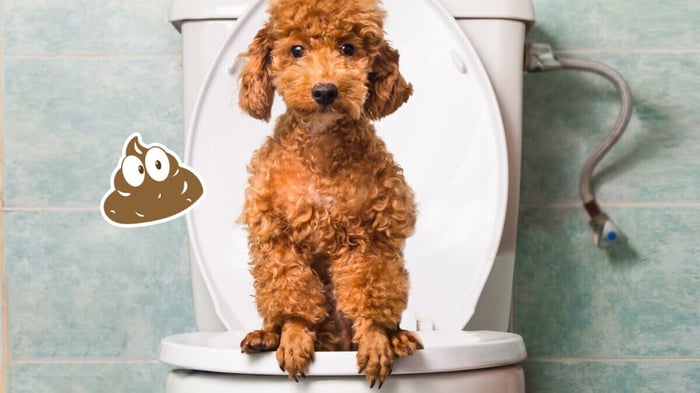Occasionally, pet parents may notice tiny white specks in dog poop that either move or don’t. Obviously, any change in our dog’s bowel movement can make us worry. After all, a poop inspection may not be the best part of your day, but it certainly provides insight into your dog’s health. And it’s one of the many reasons that it’s vital to keep our dog’s gut healthy with good nutrition and canine probiotics.
The causes of white specks in dog poop usually depend on whether or not they’re moving. Moving white dots in the stool are a sign of worm infestation, such as tapeworms. Non-moving white dots are unlikely to be a concern as they may be specks of food like rice or bone segments. But they could also be worm eggs.
It’s alarming when your dog’s stool changes color and consistency because it can indicate severe illnesses like parvo or colitis. Here’s all you need to know about white specks in dog poop and what to do about it.
So, What Causes White Specks in Dog Poop?
Parasites and undigested foods or swallowed are the likely causes of dog poop with tiny white specks. Often white specks in dog poop not moving are harmless food particles like rice or something else your dog ingested. Moving particles require prompt veterinary attention for tapeworm treatment.
If you’re googling “white specks in dog poop giardia,” don’t worry. Dogs infected with giardia usually have green, watery poop. There may be mucus or blood in the feces. Normal brown dog poop with white spots is not giardia, although it may still be a parasite infestation.
Don’t freak out too much because white spots are common in dogs and are easily treatable. Here are five causes of white specks in dog poop:

1. Worms
Tapeworms, roundworms, whipworms, and hookworms are dogs’ most common internal parasites. Of the three, tapeworm egg sacs are most likely to manifest as small rice-like dots in the poop. These eggs are not moving white specks, so you’ll need a second to spot them.
However, tapeworm segments can fall out your dog’s butt, in which case you will see some wriggling, white worms. Yes, it is extremely gross!
Hookworms are unlikely to show in poop as they lodge in the intestines, mooching off blood and essential nutrients. They’re too small to see, and even if you do, they look more like thin strings than white spots. Likewise, whipworm’s eggs are microscopic and invisible to the naked eye.
Roundworms also look like thin strings, and some describe their look as spaghetti.
Now that we’ve determined that the moving white fatty lumps in dog poop may be a tapeworm infection, here are some other signs of worms in dogs. You may notice these long before seeing the white spots in poop.
- Rapid weight loss;
- Vomiting;
- Diarrhea;
- Lethargy;
- Potbelly;
- Dragging butt on the floor; and
- Poor coat appearance.
It’s good to see white spots in poop after deworming because the treatment worked, and the worms are dead.
2. Undigested Food Particles
White specks in dog poop that are not moving are probably undigested leftovers from their dog food. Maybe your dog gobbled up too much rice or other grains like corn, now showing in the poop as white spots.
Malabsorption can cause increased white particles in poop due to failure in digestion. Your dog may display weight loss, hunger, pica (eating non-food items), and lethargy even when generally eating if they are not properly absorbing their dog food.
It’s always vital to note any changes in your dog’s feces. This includes changes in dog poop color, such as green poop, as this can indicate severe digestive problems with organs like the gallbladder or even that a dog ate rat poison or another toxin.
One should also pay attention to the consistency of dog poops (runny or very hard are both bad), the cover (mucus or blood), and even the smell. For instance, there is a very specific parvo poop smell.
Undigested food particles are more common in dogs suffering from diarrhea because digestion doesn’t occur properly. If tough white spots are frequent in your dog’s stool, you might consider changing to higher-quality foods and treats.
3. Bone Bits or too Much Calcium
Dogs enjoying a raw diet may get more than their fair share of bones. If undigested bone bits pass to the stool, you’ll see hard white chunks in the dog poop. Eating large amounts of bone can also cause constipation, which may need you to massage your dog to poop.
White poop that is hard and crumbly usually indicates too much calcium in the diet. Remember, if a dog eats too much of any nutrient, they can suffer from severe health issues, which is why diets must be carefully balanced.
Some commercial foods contain plentiful ground bone that your dog may not fully digest, resulting in white spots in the stool. Undigested bone in the poop differs from chalky stool due to too much bone in the diet, causing excessive calcium.
4. Foreign Objects, Including Pills
Your dog’s poop can tell you a lot about what they’ve been up to outside, such as eating outdoor and indoor items. You may see white pieces of toys, strings, and even socks in the poop if your dog indulges in indiscriminate eating.
These foreign items are dangerous because they are a choking hazard and can cause bowel obstruction. White specks in poop can also indicate the presence of medicated capsules that pass through the digestive tract.
Regarding indiscriminate feeding (pica), dogs can also eat other dogs’ poop. It’s not just gross, as it can even cause diseases like Parvovirus, particularly in puppies, responsible for the infamous parvo poop smell.
5. Fly eggs
Fly larvae or maggots appear almost like pale worms and infest exposed poop after some time, even if the stool is healthy. You’ll not see white spots in the poop if you pick it up immediately since the maggots haven’t yet infiltrated.
Fly larvae may live inside your dog (intestinal myiasis) when they consume contaminated food. This is a rare condition because these organisms hardly survive in the body, but a vet can say for sure. In most cases, poop left for a while probably has white spots due to maggots outside the dog’s body.
Treatment: What Should I Do If My Dog’s Poop Has White Specks?
1. Deworming
Since worms are the most common cause of white spots in dog poop, deworming is the best solution. Take your dog as soon as you notice white, wiggly particles in stool and other clinical signs like diarrhea and weight loss, especially for young puppies who aren’t as robust.
Prevention is the best cure for worms in dogs. Regular deworming every three-to-six months keeps your dog parasite-free, especially from the more harmful worms like heartworms and hookworms. Your vet will prescribe the best pill, but you can find most over the counter.
Remember to deworm the entire household at the same time, including all other pets and humans. Worms can transfer between any mammal in the home, and it is possible to reinfect your dog with worms if you don’t deworm yourself at the same time.
2. Control your dog’s environment
If the white dots are due to foreign objects, take the time to remove socks, plastics, and other objects from the surroundings. Keep your dog leashed during walks if they run for it and come back with foreign items in the mouth.
Ensure your dog is crated or stays in areas where they don’t have access to items they may chew and swallow. Also, make sure your dog has plenty of appropriate chew items to gnaw on that are safe to swallow.
Your dog may not eat enough for its size and weight, causing increased interest in non-food items. Consult your vet if the indiscriminate eating becomes excessive, as it may indicate malabsorption. However, most times, dogs eat foreign materials for fun, and it isn’t a cause for concern.
3. Monitor bone consumption
Bones are tasty treats for dogs, but moderation is imperative. Ensure your dog chews on bones twice a week for 15 minutes each time to prevent excessive calcium consumption.
Give your dog tasty chews instead of bones to prevent them from over-indulging. These don’t just treat your dog, but they also keep them busy and improve dental health. Giving your dog all the bones they want may seem like the right thing to do, but it harms your dog in the long run.
Final Thoughts
White specks in your dog’s poop aren’t dangerous and indicate worms at worst. However, worms should never be ignored because they prey on your dog’s nutrients, affecting their health. Consult your vet if you notice wiggly white dots in your dog’s poop for deworming because those are tapeworms.
Hookworms are much more severe as they feed on the blood and can cause anemia and other health complications. Sticking to deworming every three months generally keeps you in the clear. Undigested food and bone, pills, foreign objects bits, and fly larvae are causes of white specks in poop that don’t move.







